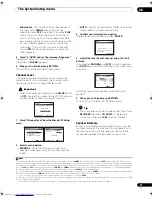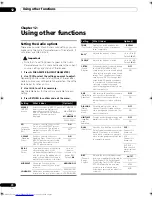
Other connections
09
57
En
Press repeatedly to choose a speaker system option:
•
SP
A
– Sound is output from speaker system A and
the same signal is output from the pre-out terminals.
•
SP
B
– Sound is output from the two speakers
connected to speaker system B. Multichannel
sources will not be heard. The same signal is output
from the surround back channel pre-out terminals.
•
SP
AB
– Sound is output from speaker system A (up
to 5 channels, depending on the source), the two
speakers in speaker system B, and the subwoofer.
The sound from speaker system B will be the same as
the sound from speaker system A (multichannel
sources will be downmixed to 2 channels).
•
SP
(off) – No sound is output from the speakers. The
same sound is output from the pre-out terminals
(including from your subwoofer, if connected) as
when selecting speaker system A (above).
Bi-amping your front speakers
Bi-amping is when you connect the high frequency driver
and low frequency driver of your speakers to different
amplifiers (in this case, to both front and surround back
terminals) for better crossover performance. Your
speakers must be bi-ampable to do this (having separate
terminals for high and low) and the sound improvement
will depend on the kind of speakers you’re using.
1
Connect your speakers as shown below.
This illustration below shows the connections for bi-
amping your front left speaker. Hook up your front right
speaker in the same way.
Since both front and surround back speaker terminals
output the same audio, it doesn’t matter which set (front
or surround back) is powering which part (
High
or
Low
)
of the speaker.
• Make sure that the
+
/
–
connections are properly
inserted.
2
Select the ‘Front Bi-Amp’ setting from the ‘Surr Back
System’ menu.
See
Surround back speaker setting
on page 42 to specify
how you’re using the surround back speaker terminals.
Caution
• Most speakers with both
High
and
Low
terminals
have two metal plates that connect the
High
to the
Low
terminals. These must be removed when you are
bi-amping the speakers or you could severely
damage the amplifier. See your speaker manual for
more information.
• If your speakers have a removable crossover network,
make sure you do not remove it for bi-amping. Doing
so may damage your speakers.
Bi-wiring your speakers
The reasons for bi-wiring are basically the same as bi-
amping, but additionally, interference effects within the
wire could be reduced, producing better sound. Again, to
do this your speakers must be bi-wireable (that is they
must have separate terminals for the high and low
frequencies). When bi-wiring, make sure you’ve selected
Normal (default)
or
Speaker B
in
Surround back speaker
setting
on page 42.
•
To bi-wire a speaker, connect two speaker cords to
the speaker terminal on the receiver.
Caution
• Make sure you use a parallel (not series, which are
fairly uncommon) connection when bi-wiring your
speakers.
• Don’t connect different speakers from the same
terminal in this way.
(TUNE)
(TUNE)
PHONES
PARAMETER
SETUP
(ST)
(ST)
AUDIO
VIDEO
TUNER EDIT
SPEAKERS
BAND
CONTROL
ON/OFF
SIGNAL
SELECT
STEREO/
F.S.SURR
SB ch
PROCESSING
VIDEO/GAME 2 INPUT
DIGITAL IN
S-VIDEO
VIDEO
L
R
AUDIO
MULTI – ZONE &
SOURCE/REC SEL
MCACC
SETUP MIC
RETURN
ENTER
USB
SELECTABLE
SPEAKERS
FRONT
R
L
R
L
R
L
(Single)
CENTER
SURROUND
SURROUND BACK /
A
B
High
Low
Front left
speaker
VSX_LX60LX70.book Page 57 Wednesday, June 6, 2007 3:13 PM
















































